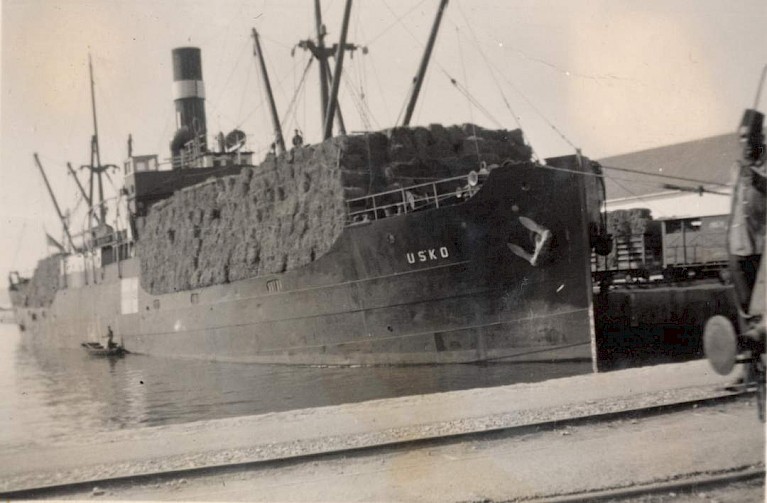
S/S Usko sinks in Stettin bombardments
Just after midnight, an air-raid warning sounded in Stettin. The Royal Air Force bombarded the city with 460 heavy Avro Lancaster bombers, each one carrying a bomb load of 6400 kg. Part of the planes had Canadian crews. They dropped both big explosive bombs that broke walls and roofs, and small fire bombs that started fires inside the damaged buildings in Stettin.
As the bombs started falling, one of the Usko’s junior seamen was just returning from the shore. The apprentice who stood night watch was going to fetch him with the ship’s boat. The junior seaman escaped by jumping into the water from the wharf, but the apprentice ran to seek shelter on land. He never reached the bomb shelter, but was killed by shrapnel. The ship’s boat remained on the shore.
Several bombs hit the Usko, which resulted in a bad leak. The fire bombs set the timber cargo on fire on the deck. The crew made an effort to put the fire out, but failed. The telegraph operator swam to a nearby island where he found and grabbed a row-boat. He rowed beside the Usko and started taking the crew members to the island from the burning and leaking ship. The boat, too, had suffered in the bombing and could only carry a few persons at a time.
Those most severely wounded were saved first, next the two female crew members, then the rest. Master and experienced captain Edwin Wene was the last one to abandon the Usko. Two stokers were never found, and one wounded man died after having been brought to the island. Many had suffered severe injuries in the bombing, and the Usko crew helped them as best they could. Medical orderlies from a German anti-aircraft unit also helped. Efforts were made to extinguish the fire, but the Usko sank at dawn.
Daylight revealed a nightmarish sight in Stettin. Fires everywhere, scattered aluminium foil dropped from the planes; it was meant to disturb the anti-aircraft radar control. Many buildings had collapsed. The Usko had lost four members of her crew; six others were so badly wounded that they had to be hospitalized. It was a difficult and dangerous way from the port to the hospital, through the burning ruins. The last 12 members of the Usko crew started for home on Finnish S/S Regulus which had not been hit.
The hospitalized crew members were treated well at first, but things changed in a few weeks. Finland and the Soviet Union concluded peace, after which the Germans practically considered Finns enemy citizens. The Swedish consul assisted two of the patients to Sweden and on to Finland. The other four returned home by various routes as late as 1945, after Germany collapsed.
The strategic bombings by the Allied Powers aimed at weakening Germany’s military capabilities in three ways: by destroying the war industries; by destroying the homes of their employees, weakening their ability to work; and by breaking the morale of German civilians through massive destruction. The Stettin bombardment on the night between August 16th and 17th was part of this strategy. As many as 100 000 people lost their homes that night. There is no reliable estimate about the number of casualties, but official German documents show that there was shortage of coffins in the city.
The bombings were perilous for the attackers as well. The Royal Air Force lost dozens of aircraft at Stettin, dropped by anti-aircraft units and fighter planes. Some crews managed to parachute from the dropped planes or to climb out of the wrecks after forced landing. Most of these pilots became prisoners of war. In a way, they shared the destiny of the Usko crewmen who were hospitalized.